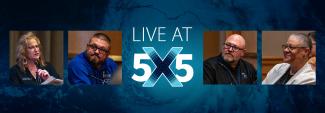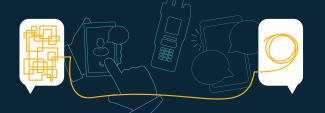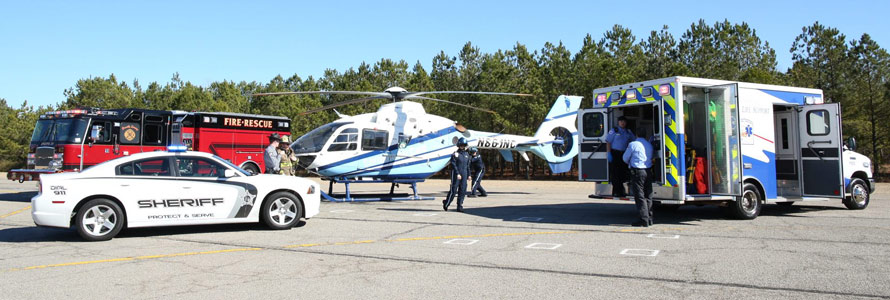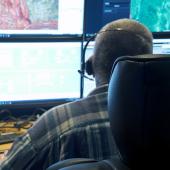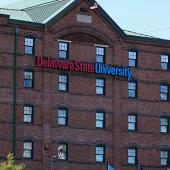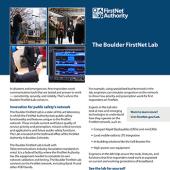Summary
Females are statistically underrepresented in public safety and in science, technology, engineering, and math (STEM) career fields. At the intersection of STEM and public safety, there are women developing innovative solutions to make first responders’ jobs easier and more efficient. Working on this technology takes tenacity – but those who rise to the challenge are making an incredible difference.
Guest
Jennifer Harder
FirstNet Authority Director of Roadmap Domains
Alison Kahn
Electrical Engineer, Public Safety Communications Research Division, National Institute for Standards and Technology
Jessica Ballew
Chief of Infrastructure, Texas Department of Public Safety
Transcript
Preview
Narrator: You're listening to Public Safety First, a podcast to help you learn about the First Responder Network Authority and how you can be part of the future of public safety technology.
And now, your host.
Narrator: You're listening to Public Safety First, a podcast to help you learn about the First Responder Network Authority and how you can be part of the future of public safety technology.
And now, your host.
Jennifer Harder: Welcome to the Public Safety First podcast. I'm Jennifer Harder, Director for Roadmap Domains at the First Responder Network Authority. And today I'm honored to be joined by Alison Kahn, Electronics Engineer with the Public Safety Communications Research [PSCR] Division at NIST [National Institute of Standards and Technology], and Jessica Ballew, Chief of Infrastructure Operations for the Texas Department of Public Safety. Alison and Jessica are both leaders in public safety communications technology. And today we're going to discuss their experiences as female leaders in STEM, their roles in developing technology for first responders, and how research and innovation are going to change the field of public safety. So, Alison and Jessica, thank you so much for taking the time to talk with us today. Let's start, Alison, with you. Can you introduce yourself and tell us a little bit more about what you do?
Alison Kahn: Thanks so much, Jennifer, I'm Alison Kahn. I work with PSCR in Boulder, Colorado. I am an electronics engineer, formerly a background in computer science, but I'm also working on their public safety Internet of Things research. I'm the project lead for that research. So, I've been doing quite a few things surrounding personal area networks for first responders, how first responders can get information from different data sources as we enhance communications in their fields. I've been in telecom for the past 18ish years, and I'm just really happy to be here today. Thank you.
Jennifer Harder: We're so glad to have you. Hey, Jessica, how about you? Can you introduce yourself and tell us a little bit more about what you do for Texas?
Jessica Ballew: Sure. It's Jessica Ballew, I’m the Chief of Infrastructure Operations at the Texas Department of Public Safety. And that is inclusive of several different support service areas that helps ensure that the rest of our operation here can run smoothly. So, that includes our fleet management, facilities management, procurement and contracting, and our public safety communications organization. Thank you for having me on today's podcast.
Jennifer Harder: We're so glad to have both of you. So, it's interesting, right? Different careers, different opportunities and all the ways that we come together. And now the three of us are really working with public safety in these really unique STEM support functions. But I think the three of us may know better than most. Working with public safety isn't always the easiest thing to do. There's lots of challenges, lots of creativity that have to come into the space. Jessica, I thought I'd start with you. What are some of those challenges that you've run into trying to accommodate some of these 21st century technologies to some of the public safety operations that your guys are experiencing out in the field?
Jessica Ballew: You know, I think there are multiple challenges, but that's what keeps it fun and interesting. But, you know, I think as a government entity, probably our biggest challenge is being able to innovate because we have to operate under so many constraints in regards to budget cycles and procurement rules and things of that nature that we must follow, which makes it hard to really posture yourself to, you know, be able to be extremely agile, right. You have to be creatively agile and you kind of have to plan to innovate as opposed to being able to go buy what you need and test it out and figure it out. I mean, there's a more methodical and long-term approach that has to happen to that.
And so, what we've recently done in response to that challenge is we've established our Public Safety Solutions Center, and we've pulled a few individuals in that can really focus on trying to predict the areas where we might want to innovate or we might want to explore future capabilities. And by having some folks focused on that research and partnering with our procurement and contract services team, it's enabled us to be able to work a little more in an agile fashion. It has given us a way to be able to prove a future capability so we can get it into a budget cycle and through all of the procurement rules. We've come up with this cool way of managing to those constraints now where it's historically been a much larger challenge for us.
Jennifer Harder: But that's fantastic, just the ability to work around the system and through the system to get to those innovations and to get to ones that really work, right, for the responders there in Texas, I think is pretty fantastic.
Alison, how about on your side, any of the challenges that you've had working on the engineering component of public safety and any of the unique or neat rewards that have come out of getting it right?
Alison Kahn: It's been interesting because working on the research side of things, we interact with such a wide variety of stakeholders coming from all different areas, all different region sizes, dealing with all sorts of communications issues. And to think of public safety's challenges, I mean, when you have a commercial communication solution and something bad happens and your coverage goes out, it's just kind of, "Oh well, you'll have to deal with that." But for public safety, they're in an environment that is more apt to those types of challenges and they still need to be able to communicate. So, I found it very interesting the types of resiliency that we need to factor in for public safety, the type of ruggedness that we need to factor in for their equipment. There's so many different environmental factors that need to be thought of when introducing technology into the environments that first responders have to deal with on a daily basis. And that's been such a unique learning experience for me, because you never think of these environments coming from a commercial industry perspective.
And the other thing to keep in mind is that first responders have been communicating and getting things done without our technology for years and years and years, and trying to introduce technology in a way that it actually meets their needs and actually helps them to communicate better is very hard. But in interacting with our stakeholders over the past few years, there have been times where we can finally come together and I can introduce things that I've been working on and they can see how it could actually meet their needs and make their communications easier. And I would say that's a super rewarding part. Technology isn't meant to be an interference. We want to hear what they're saying, understand what their requirements are and bring that technology to them. And I think that's been one of the most rewarding parts of the job. When we can finally find a way to say this meets the requirement that you've been telling me about. This can help you in a way that moves beyond the traditional commercial experience.
Jennifer Harder: That for sure resonates with some of the experiences I've had in my career where, really, when the technology is right, it becomes invisible again. It's just natural and it flows into what they're trying to do and it slides right into the background because it just makes their response operation more efficient, more effective, more safe, it doesn't stop them in their tracks. It’s rewarding when you find that right fit and those things go together well.
So, thinking along how you got to where you are in your careers today. If you're anything like me, certainly, it was not a straight road. I'm going to ask Jessica, when you started out, where did you imagine you'd end up? Was it here? Was this kind of where you thought your career path would take you?
Jessica Ballew: You know, I didn't expect to end up where I'm at today by any means. When I started out at the Department of Public Safety, I was in college and I was working on a computer science degree at the time. I got a job as a microfilm clerk in the driver's license department. The agency and other government entities created these junior programmer positions. And so, I ended up going for that, got it. And did a lot of on the job learning. And I loved it so much. You know, I stayed in that role for quite a few years and progressed to more advanced levels and then to have the opportunity to work on things like our original in-car computing system and CAD program, our criminal history system, our gang data. And there was a number of systems that I got to help design and build and code. And I loved it.
When I was in my early twenties, I thought at some point I'll probably transition and go work for one of these big tech companies because I really loved working with people and understanding what they needed and then coming up with a solution. But I never ended up leaving. I had several opportunities. And every time it came down to making the decision to stay or to go, I realized that what I really loved was the mission. And, you know, there's no other industry that can compete with the mission of the Texas Department of Public Safety, which is simply to protect and serve. And at the end of the day, the satisfaction and, you know, the awareness that you and your teammates have all really done something for the greater good, no matter how exhausting or complex or, you know, good or bad the day was, you go home at night and you know that you made the world a little bit better through what you did. And it may not be directly, right. We may be making it better through our troopers and rangers and agents and pilots and those who are actually on the front line. But in absence of what our team does, they wouldn't be as successful in those roles. You can't get that kind of a feeling anywhere else. And so, I stayed here because of the mission and the people and the environment that we have here.
Jennifer Harder: Yeah, that mission orientation, I don't know how you beat it. If there's someone coming up in this industry today or any industry and they have to find that thing that they love. To your point, once you find that thing that really solidifies why you're doing what you do, I think that changes the whole job for you into a career over time.
Alison, how about on your side? Did you have similar winding roads and detours that got you into the engineering field, and into PSCR, or was your path a little more straight point A to point B?
Alison Kahn: It definitely hasn't been as windy as some people's roads. When I first got out of college, I started working in the telecom industry, supporting some network test organizations, writing software to help them refine their test process, automate their test process. And it was interesting work. I had never really been exposed to the telecom industry and cell phones were just really starting to pick up and get popular. They put me on this program running tests for one of our vendors to set up the test program and work with customers to test their phones on our equipment. And I started doing that and it got me out talking to people and interacting with external clients and dealing with new technologies. And so, it wasn't what I had expected at all. And I did enjoy it. And it was, you know, quite a change for me.
When I came to PSCR, once again, it was new because I had never been in a research environment. You know, I wasn't sure how to deal with the fact that I could explore different ideas without there being a right or wrong end result. And this has just been such a cool experience for me to see what paths we can take public safety communications in, where the technology is going, how that can make public safety's mission more efficient, more reliable. So, it's been an overall pretty straight path, but there have definitely been some junctures that have taken me very far off from where I originally anticipated.
Jennifer Harder: As you talked, I was laughing at my own sort of detour. I had just finished up my doctorate and I was really intending to do some behavioral psychology work. I was working with dolphins actually at the time. I was working with my search and rescue dog. Well, I just couldn't seem to really solidify what I wanted. And I went ahead and applied for a police department back home and I got accepted. So, here I am with my doctorate. I'm about to go back into the police academy. And the last weekend before the academy start, my last attempt to work my search dog before I had to move and I fell working with him and shattered both arms at the same time. And so, somebody had to hold the phone to my ear to call the police chief, "Sorry, sir. This is just not going to happen. I can't use my arms."
From that moment, it was literally a 180 pivot into a couple different careers that have led me over time to get to FirstNet and to support public safety communications from this whole different side of the equation that never would have happened if I'd have gone down that original path. So, sometimes, the pivots are small and you don't get to go down the path you meant. It's one of those things just being open, right. We're all just kind of open to the careers that come to us, and we're all three of us interested in a challenge and that takes a lot of tenacity. This is not a career path for the timid, right? That tenacity comes into play, being persistent, not turning around when there's an obstacle, but being willing to work and pivot around that obstacle. And Alison, we'll have you go first on this one. Was there ever a time in your career when you just ran smack into one of those obstacles and you figured out a way to get around it, to keep your project moving?
Alison Kahn: I think we've all just probably come out of the biggest obstacle of everyone's career with 2020 and the COVID alterations that we've had to make to our work and our life. That's probably been the most unique and having to reconfigure my research to deal with working remotely, not seeing people in person, not having the equipment that I'm used to in the lab has definitely been a huge pivot. I think being in engineering, being in technology fields, you really, you know, hone the ability to think outside the box, to gather the tools that you need to do what you need to do. And, you know, the obstacles that we encounter at the time, you can look back and kind of think, "Oh, it didn't turn out to be as bad as I thought it would be." But it's definitely been a learning experience all throughout my career.
Jennifer Harder: How about on your side, Jessica, have you run into anything that, at the time you were like, "This is insurmountable," and now looking back, you're like, "Oh, no, that was there for a reason, and getting around that was a good accomplishment for us"?
Jessica Ballew: All the time. I think that's the thing that keeps us on our feet and helps us continue to grow and get better. In our public safety communications program, we are really looking at trying to modernize that whole system and to position ourselves to be able to provide more real-time operational awareness and information to not only, you know, assist with a call from a citizen or to provide support services to the trooper on the side of the road, but really to also be more in a crime fighting mode, if you will, and supporting all of our law enforcement operations, because there's just so much information out there that we can take advantage of today if we have the understanding of how to use it and the tools to be able to use it successfully. And so, you get these great ideas and you get real excited about it because you know that it's going to make a huge world of difference on the back end of a big project like that. And then you realize how much the project is going to cost. And that's where you run into the big brick wall because new technology is real expensive. As it evolves, you know, it typically becomes more affordable. But, you know, the types of things that we're going to do and the different types of systems that we're looking at and different tools, that comes with a pretty hefty cumulative price tag. And so, we had to take a step back and say, “OK, you know, we're not going to be able to do this overnight. It's going to be a multiyear approach. So, while we're kind of concurrently figuring out how do we get the funding to do all of this, what can we do now? What could we do today?” And I'm telling you what, man. You put people in the room together and you set some objectives and it's amazing how resourceful they are and the types of ideas that they come up with to get to yes. So, we've taken some existing systems like the license plate reader solution, for example, and we've now placed that into the hands of our operators so that they have the ability to go in and look at that data and establish, you know, possible traffic pattern for a particular individual. They have the ability to identify whether or not there is potentially a stolen vehicle in the area and they can send a troop there proactively as opposed to being more in a reactive posture. And so, just the little things like that we were able to take advantage of and roll out incrementally really helps you to get over those hurdles and actually keep running the race. So, I think a lot of those obstacles are truly blessings in disguise when you take a look backwards and see where you've come from it.
Jennifer Harder: Yeah, that makes good sense to me. Necessity being the mother of invention. And I think sometimes obstacles are the father of opportunity. And I think public safety as an industry is full of folks like that who are just so good at looking at things from different angles and coming up with solutions maybe we never thought of, right. So, capitalizing on them and bringing them into the picture is really helpful.
And Alison, I'm going to guess you've done that with some of the work you've done on the Internet of Things, IoT, type of technologies. Have there been any technologies that when you first saw them you're like, "Well, this is the quirkiest, oddest widget I've ever considered," but at the end, it really worked out, something for public safety really clicked with it and it made a difference?
Alison Kahn: I think some of the most interesting things that I have seen for public safety in the IoT space deal more with their environment than the data because the data is going to be the same no matter what industry you're looking at, but the environment is where you really start seeing the challenges for public safety. And so, I've really seen some interesting responder location devices that have been put into the firefighter helmets, for example, because they have such a problem with decreased visibility when they're in a building filled with smoke. And that's when firefighters can really become disoriented. They're creating location devices that don't need to be charged every few hours. I also recently saw a pair of boots that can be used to generate a charge for devices. So, as you are walking, you can actually connect to something that would need powering and the boots would actually start generating the power, which is really cool. So, I think the most unique devices that I have seen are really dealing with structuring that first responder environment in a way that electronics can be utilized when they most need to be.
Jennifer Harder: I love hearing the unique stories. I love hearing when there's something commercially that they've tried to use and it gets pivoted and adjusted to be something more impressive for public safety or when there's something that they don't have and they create it. So, I think those are some of the more fun stories, right, that come out of some of the innovation spaces that you guys are in.
Jessica, when it comes to fielding innovative public safety technologies, we know that the proof is when they take it out in the field and operationally, it works for them. It could be the coolest idea ever, but if it doesn't make that responder safer, faster, more effective, more available, it's not worth it. In your work with Texas DPS, are there examples of cases where a technology innovation really made the difference in the outcome of an emergency or an investigation?
Jessica Ballew: There are so many examples of that. An innovation could be something that sounds as simple as letting us communicate after a disaster like a hurricane where towers have been damaged and communications are, you know, nonfunctional in certain areas. Even something as simple as our COWs or our mobile radio towers that can be deployed in a situation like that can make all the difference in the outcome of an emergency situation.
Another example is a murder we were able to solve. There was a teacher murdered in Beaumont, Texas, back in 1995. And at the time, the technology wasn't there to figure out and solve that particular case. But our Texas Rangers cold case unit were actually able to use genetic targeting to solve that murder by doing the DNA genealogy and familial searches. You still have to have police work. You still have to have the human factor that goes in and puts all the pieces together and comes to the conclusion based on facts. But in absence of having that type of technology, I don't know that, in this particular case, that the case would have been solved yet. And so, we're really embracing a lot of technological advances at the department to solve crime and get the bad guys off the street.
Jennifer Harder: Thinking about women in public safety, women in STEM, women in leadership roles, women in strong positions in their careers. A lot of us got here through mentorship and through input and through advice from other people. Jessica, I'll start with you. What's the best advice you ever got in your career? How did it help you get where you are today?
Jessica Ballew: I think the best advice I ever got started out with the worst advice I ever got. So, I had a manager that I was working for at the time and he was explaining to me that you know, "You're great, you're smart, you know, all this wonderful stuff, but-" and he essentially let me know that I might want to pay more attention to my style and delivery, because I could come across as very masculine in the way that I spoke and shared information and gave direction, and that I should probably work on being just a little bit more feminine in that delivery. Nothing like that would even come close to flying, no one would even think about saying something like that with our current leadership. But 20 years ago, we hadn't quite advanced to the place that we are today. So, I was real, you know, disturbed by that. And I went back and I talked to a different leader in our organization and also happened to be a male supervisor. And I said, you know, I'm just not sure what to do with this because I want to make sure I'm doing what's right for the team, but I don't know how to be different, right? That's my personality. That's how I've always been. And that gentleman said to me, "Do not listen to that. Get that out of your head. You've got to be you, you've got to be genuine, because if you're not going to be the real Jessica, people are going to know it. And you can't have successful, trusting relationships when you're not being your authentic own self." And I thought about that so many times. And I can be a little stubborn, a little direct, admittedly. But that directness, I think, is one of the things that's actually put me where I am. Because when there is a problem, I have never been the type of person to sit back and keep quiet about it. I've always been the kind of person that will jump in and assert an opinion or provide a recommendation, especially if it's something that I think is going to be problematic. And there are serious consequences to issues in a public safety organization, very serious consequences. And so, you have to get things right and you have to swiftly get them right. And so, when I really look back on it, you know, I got my worst advice and my best advice the same day.
And then the other I will say is, if you do the right thing for the right reason, it will end well. It may not be a popular decision or recommendation, but if it's the right thing to do and you're doing it for the right reason, then you can you can go home and sleep easy, and it’s ultimately going to get to a positive result.
Jennifer Harder: Yeah, those are fantastic, I'm still taken aback by the idea of being direct and clear and forceful was too masculine. It's interesting these traits, right, that get ascribed one way or another and where they're perceived as good, capable characteristics of someone in a position and where they're perceived as maybe something that needs change. So, that was a fascinating example.
Alison, how about you? Any great advice or just what were you thinking atrocious advice that you've gotten over the years?
Alison Kahn: I think my best advice is to take the opportunities that you're given, because a lot of times, when I had been given opportunities that I felt were out of my scope or out of my comfort level, my manager at the time was like, do it. I mean, you'll rise to the occasion or you'll learn something about what you enjoy doing, where your strengths are, where your weaknesses are. Don't ever turn anything down for, you know, comfort-level reasons or things like that. And that was a huge piece of advice for me.
My worst piece of advice, I have to tell this story, because it just kind of cracked me up. When I was a couple years out of college, I was doing a performance review with one of my managers, and I was asking him at the time, you know, "What can I do to take my career to the next level and how can I move forward?" And he looked at me and he was like, "Alison, let me tell you a story." And he said, "When I was a kid, my grandparents had chickens. And one day, they brought home a black-and-white chicken. All the rest of their chickens were brown. And they put the black-and-white chicken in the coop and left it as normal and came back the next day and the black-and-white chicken was gone. All that was left was a beak." And I looked at him and he looked at me and then he looked at his watch and he was like, "I've got to go." And my takeaway was that I was a black and white chicken in a room full of brown chickens. And I don't really know what the purpose of it was, but it definitely made an impact for a few years as far as the need to conform, the need to stay within your ranks, the need to be a brown chicken, even if you were a black and white chicken. And, it took a good long time to get out of that mentality for sure. So, I mean, the workplace, there's definitely stories and there's definitely roads that you will navigate, but they ultimately make you more thankful for the place you end up eventually.
Jennifer Harder: And you know what I'm thinking as I'm listening to you both and your stories and places that you've come through as you've come up in your careers, it seems like one of the skills that we need to pass on to our daughters and our colleagues and our friends is the ability to sort the good advice from the bad, to not take it all in, to not spend X number of years worried about being a brown chicken, but really to think, you know what, I hear that person's input. I can make good decisions based on that and I can move my career forward or I could equally hear that input, you know, everyone's got opinions they're entitled to, but we're going to go ahead and discard that one and we're going to move on in a different direction. And sometimes I think having the confidence to do that makes all the difference.
So, I'm going to take full advantage of having these wonderful women here to give us some thoughts. FirstNet Authority right, we are really focused on moving that needle positively for public safety communications and finding ways to make a difference. So, the challenges that face first responders and you guys in your own careers, in ways, are on the front lines of that. And Jessica, I want to pick on you first. What are the loudest complaints, the loudest needs, the loudest challenges or problems that you're hearing on that public safety communications front coming out of your officers at Texas DPS?
Jessica Ballew: So, I think that one of the biggest challenges that we face in the public safety domain right now is still being able to share information across the board and take advantage of the data that's out there and even some of the data that may be available to the public but that may not necessarily be easily consumed by us and our public safety, law enforcement purpose and even between law enforcement entities and other public safety groups, because of all the different types of technology and in some of the different levels of technology that we're using, that interoperability with data can still be a big challenge to overcome. And some of that I think plays into still, you know, the trusted authentication. I think that that plays a role and trying to make sure that we're interoperable and secure and the right person is able to view the information for the right reason. And then you factor that in with some sort of significant event that requires a coordinated response and being able to collaborate in real time and share the data in real time. I think those are some, some challenges that I look forward to being able to partner with other agencies to solve just to be able, to provide our law enforcement with the additional tools for a successful response to those sorts of events.
Jennifer Harder: I love it. The idea of treating public safety almost as a singularity that we can move information around appropriately within. And it's such a challenge today. It is so hard to do some of those basic things, kind of, across departments and between agencies and states.
Alison, anything fun or interesting or challenging coming out of some of the stakeholders that you're engaging with?
Alison Kahn: Yeah, we hear so many different stories related to unique experiences from different first responders. One of the huge ones that the FirstNet Authority is trying to take care of is the availability of the higher speed networks, particularly from our rural stakeholders. And that's where you guys are really leading the forefront to getting the higher-level technology of service, the 4Gs, the 5Gs out there.
Jessica's point regarding interoperability and availability of data is also huge. I mean, there's so many people trying to work on that effort. And even though the structure of the data is one thing, the policies and the accessibilities are yet another.
And then finally, what I'm seeing, you know, just the accessibility of the technology, the need to make it available, but not intrusive. You know, we have all these ideas for headsets and gear and things that can go on your belt and things you can strap to your chest and things you can put on your air pack. But first responders don't want to have to keep track of 19 gadgets in addition to all the other gear they have and find a place for it on their existing suit. So, I think really the user interface and the user experience of the technologies that we come up with is going to be very important. And PSCR also has a research area in that field as well, just trying to figure out ways that first responders can interact with the data. Once we really figure out how to get that data to them, how can they get it in such a way that it really enhances their situational awareness and doesn't impede it? I think those are all really important questions. The first responder use case is just such a unique one and such a cool one to work on. And there's such an importance to having them have this information at their fingertips when they need it and when they're trying to help their communities and their teammates and everything.
Jennifer Harder: Absolutely. Well, we've shared so many examples of things that I think we would tell other women to really encourage them and really to be their full and authentic selves in any career path they choose. I know one that really resonates with me is one of the most dangerous things that can happen to a young woman or a girl and throughout your career is to ever learn that you have to make yourself less, that you have to be smaller, that you have to dumb yourself down to fit in, that you have to somehow change who you are as a black and white chicken to fit in with the coop, right. How do we teach women that they have to be less in order to be accepted? And it's just such this dangerous idea. We should stand tall in whoever we are and all the uniqueness and all the diversity and all the differences that we bring and use those unique traits and skills to further the industries or the opportunities that we're presenting ourselves to.
Thank you guys both really for taking the time to talk with us today and be on our podcast and really share your thoughts and opinions on the public safety communications industry and women in STEM and all of it. So, I wanted to, again, extend my sincere thank yous for you guys joining us. And it was a great opportunity for everyone to be here today on the Public Safety First podcast.
Narrator: Thanks for listening today. We're excited to have you join our podcast community. Make sure to subscribe on iTunes, SoundCloud, and YouTube. You can learn more about the First Responder Network Authority at FirstNet.gov and learn about FirstNet products and services at FirstNet.com.



